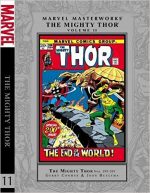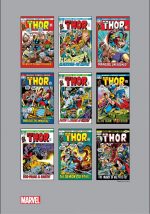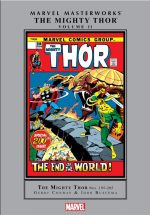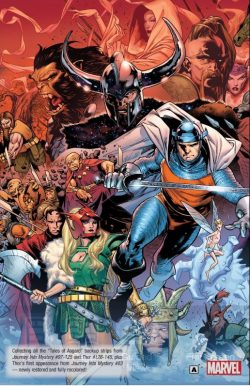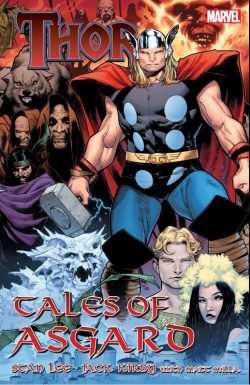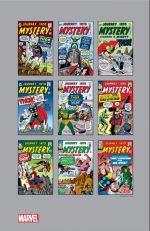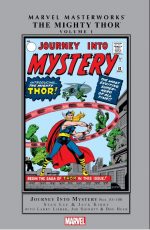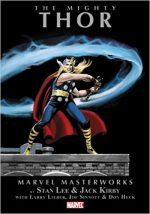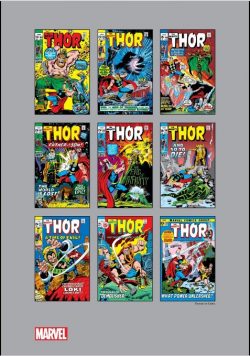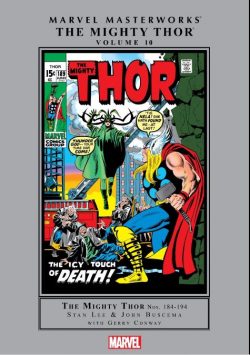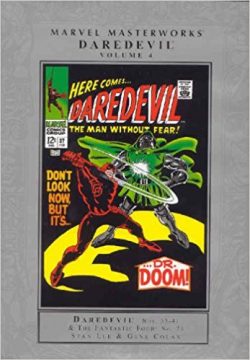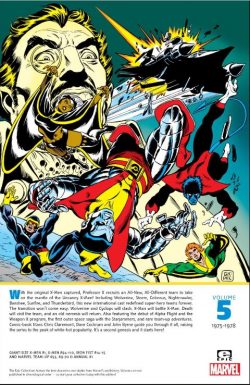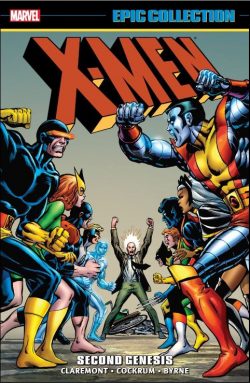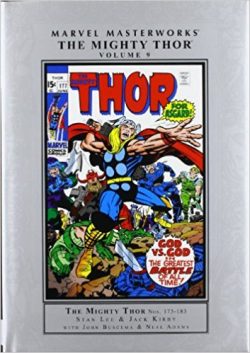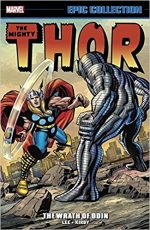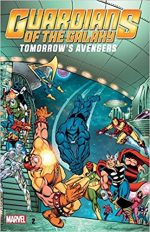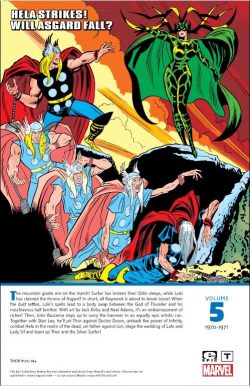
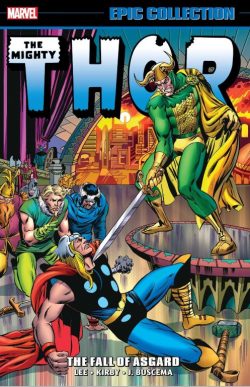
By Stan Lee & Jack Kirby, Gerry Conway, John Buscema, Neal Adams & various (Marvel)
ISBN: 978-1-3029-1274-1 (TPB)
The Mighty Thor was the title in which Jack Kirby’s restless fascination with the Cosmic Unknown was honed and refined through his dazzling graphics and captivating concepts. The King’s career-defining string of power-packed signature pantheons all stemmed from a modest little fantasy/monster title called Journey into Mystery where – in the summer of 1962 – a tried-and-true comicbook concept (feeble mortal transformed into god-like hero) was revived by fledgling Marvel Comics to add a Superman analogue to their growing roster of costumed adventurers.
This bombastic full-colour trade paperback tome – also available in eFormats – re-presents Kirby’s final Asgardian exploits and the exemplary efforts of his unlucky over-pressured successors. Taken from Thor #175-194, the sagas collectively cover April 1970-December 1971, as universe-builder King Kirby abandoned the worlds he’d tirelessly cultivated with Stan Lee for the hopefully fresher fields of DC Comics and a cosmos uniquely his own…
What needs knowing: Once upon a time lonely, lamed American doctor Donald Blake took a vacation in Norway only to encounter the vanguard of an alien invasion. Trapped in a cave, Blake found a gnarled old walking stick, which, when struck against the ground, turned him into the Norse God of Thunder!
Without any hesitation or preamble, the reborn godling was soon defending the weak and smiting the wicked. As months swiftly passed, rapacious extra-terrestrials, Commie dictators, costumed crazies and cheap thugs gradually gave way to a vast panoply of fantastic worlds and incredible, mythic menaces. Eventually the magnificent warrior’s ever-expanding world of Asgard was a regular feature and mesmerising milieu for the hero’s earlier adventures, heralding a fresh era of cosmic fantasy to run almost tangentially to the company’s signature superhero sagas. With a further revelation that Don Blake had never existed: but was a spell crafted to teach an arrogant god humility and humanity…
The astounding action begins here behind a Marie Severin cover as ‘The Fall of Asgard!’ (Lee, Kirby & inker Bill Everett) sees valiant Asgardian Balder and his Warriors Three allies Fandral, Hogun and Volstagg escape the clutches of lovestruck sorceress Karnilla only to confront the assemble hordes of giants and trolls marching on the Home of the Gods.
With All-Father Odin incapacitated by his annual Great Sleep, Loki has perfidiously seized the throne forcing war-goddess Sif to call Thor back home for perhaps the Last Battle…
Inked by Vince Colletta, ‘Inferno!’ reveals the folly of the usurper as terrifying fire-demon Surtur breaks free of ancient Odinian captivity to begin his pre-ordained task of burning down the universe.
With everything appearing ‘To End in Flames!’, Loki flees to Earth, having first hidden Odin’s sleeping form in the life-inimical Sea of Eternal Night. As Thor leads a heroic Horatian last stand, Balder penetrates the Dimension of Death to rescue the All-Father just as Surtur fires up for his fulminating final foray…
Thor #178 (July 1970) was a shock and is a landmark: the first issue without Jack Kirby since the strip’s earliest days. Clearly a try-out or hasty fill-in yarn, ‘Death is a Stranger’ – by Lee, John Buscema & Colletta – depicts the Thunderer snatched away from Asgard by the nefarious Abomination and duped into an epic clash with the alien Stranger: an extra-galactic powerhouse who collects unique beings for scientific study…
Inked by John Verpoorten, the interrupted epic riotously resumed in #179 with ‘No More the Thunder God!’ as Thor, Sif and Balder are dispatched to Earth to arrest the fugitive Loki. This issue was Kirby’s last: he left the entire vast unfolding new mythology on a monumental cliffhanger just as the Thunder God is ambushed by his wicked step-brother. Using arcane magic, the Lord of Evil switches bodies with his noble sibling and gains safety and the power of the Storm whilst Thor is doomed to endure whatever punishment Odin decrees…
More than any other Marvel strip Thor was the feature where Kirby’s creative brilliance matched his questing exploration of an Infinite Imaginative Cosmos: dreaming, extrapolating and honing a dazzling new kind of storytelling graphics with soul-searching, mind-boggling concepts of Man’s place in the universe.
Although what followed contained the trappings and even spirit of that incredible marriage, the heart, soul and soaring, unfettered wonderment just were not there any longer: nor would they truly return until 1983 when Walt Simonson assumed creative control with #337 (see Mighty Thor: the Ballad of Beta Ray Bill).
Here, however, ‘When Gods Go Mad!’ introduced the radically different style of Neal Adams to the mix, inked by the comfortably familiar Joe Sinnott, as the true Thunderer is sent to Hell and the tender mercies of Mephisto, whilst on Earth Loki uses his brother’s body to terrorise the UN Assembly and declare himself Master of the World…
In #181’s ‘One God Must Fall’ Sif leads the Warriors Three on a rescue mission to the Infernal Realm even as Balder struggles to combat the power of Thor merged with the magic and malice of Loki until Mephisto is thwarted. Then, a cataclysmic battle of brothers on Earth subsequently sets the world to rights…
The new Post-Kirby era truly began with Thor #182, as John Buscema took up the artistic reins and began his own epic run as illustrator with ‘The Prisoner… The Power… and… Dr. Doom!’
The Storm Lord is unwillingly entangled in Earthly politics when a young girl entreats him to rescue her father from the deadly Iron Monarch of Latveria. The noble scion cannot refuse, especially as the missing parent is an expert on missile technology and is capable of making Doom the master of ICBM warfare…
The decidedly down-to-Earth and mismatched melodrama concludes with Don Blake ‘Trapped in Doomsland!’ until Thor can retrieve his misappropriated mallet, but even after his deadly mission of mercy is accomplished, tragedy is his only reward…
Comfortably settled in Lee, Buscema & Joe Sinnott began crafting their own ambitious cosmic saga, opening with #184 and exploring ‘The World Beyond!’ wherein an implacable, sinister force is discovered devouring the outer galaxies, with psychic reverberations of the horrific events impacting and unravelling life on Earth and in Asgard. With all creation imperilled, Odin departs to combat the enigmatic threat alone…
Sam Grainger inked ‘In the Grip of Infinity!’, as universal calamity intensifies and the All-Father falls to the enigmatic, seemingly all-consuming invader before ‘Worlds at War!’ exposes a hidden architect behind the ultimate Armageddon. That revelation leads to a desperate last-ditch ploy, uniting the forces of Good and Evil together in ‘The World is Lost!’ before one final clash – inked by Jim Mooney – answers all the questions before celebrating ‘The End of Infinity!’
Although vast in scope and drenched in powerful moments highlighting the human side of the gods in extremis, this tale suffers from an excess of repetitive padding and a rather erratic pace. Without pause, though, we plunge on as Thor #189 sees sepulchral goddess Hela come calling, demanding Thor feel ‘The Icy Touch of Death!’ to pay for all the souls she didn’t get in the recent sidereal showdown…
After a big chase around planet Earth she is finally dissuaded in ‘…And So, To Die!’, but the distraction has meanwhile allowed ever-opportunistic Loki to seize the Throne of Asgard and unleash ‘A Time of Evil!’ This typically tyrannical behaviour results in the deranged despot using Odin’s stolen power to manifest an unstoppable artificial hunter/killer dubbed Durok the Demolisher. Unleashing his merciless engine of destruction on Earth, Loki gloats at the ‘Conflagration!’ (Grainger inks) he has instigated…
Completing the retiring of the Old Guard, Gerry Conway came aboard as writer for double-length tale ‘What Power Unleashed?’ (#193, with Sal Buscema augmenting and inking brother John) to conclude the epic tale. Prevented by vows from taking up arms against Loki’s puppet, Balder and Sif cunningly enlist the Silver Surfer to aid the embattled Thunderer as Asgard totters on the brink of total destruction.
Free to act against the real enemy, Thor then retaliates with staggering power and ‘This Fatal Fury!’: occupying the usurper’s full and furious attention until wily All-Father Odin finally resumes his rightful place.
To be continued…
The Kirby Thor will always be a high-point in graphic fantasy, all the more impressive for the sheer imagination and timeless readability of the tales. With his departure the series foundered for the longest time before finding a new identity, yet even so the stories in this volume are still packed with intrigue and action and magnificently rendered by an illustrator who, whilst not possessing Kirby’s vaulting visionary passion, was every inch his equal in craft and dedication. This book (which also includes his covers to Thor Annuals #3 and 4, plus the unused cover to #175, inked by John Verpoorten, pertinent house ads and a selection of Buscema original art pages and covers) is an absolute must for all fans of the medium, and all disciples of the modern Norse gods.
© 1970, 1971, 2018 Marvel Characters, Inc. All rights reserved.

